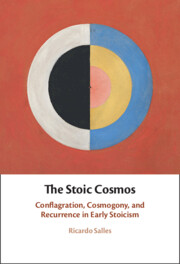Refine search
Actions for selected content:
389 results
PRISON-BREAKING FROM PLATO’S CAVE
-
- Journal:
- The Classical Quarterly , First View
- Published online by Cambridge University Press:
- 06 August 2025, pp. 1-12
-
- Article
-
- You have access
- Open access
- HTML
- Export citation
Chapter 11 - The Natural Preconditions of Political Freedom
- from Part V - Reconciling between Freedom, External Authority, and Nature
-
-
- Book:
- Platonic Autonomy
- Published online:
- 07 August 2025
- Print publication:
- 31 July 2025, pp 235-255
-
- Chapter
- Export citation
Chapter 3 - A Complex Model of Action: What Is Ruling?
- from Part II - Motivational Challenges to Self-Rule
-
-
- Book:
- Platonic Autonomy
- Published online:
- 07 August 2025
- Print publication:
- 31 July 2025, pp 58-80
-
- Chapter
- Export citation
Chapter 8 - Plato, Dialogue, and Epistemic Autonomy
- from Part IV - The Limits of Autonomy and Self-Rule
-
-
- Book:
- Platonic Autonomy
- Published online:
- 07 August 2025
- Print publication:
- 31 July 2025, pp 169-190
-
- Chapter
- Export citation
Chapter 1 - Accounts and Accountability
- from Part I - Self-Determination
-
-
- Book:
- Platonic Autonomy
- Published online:
- 07 August 2025
- Print publication:
- 31 July 2025, pp 19-42
-
- Chapter
- Export citation
Chapter 6 - The Recurring Cosmos
-
- Book:
- The Stoic Cosmos
- Published online:
- 08 July 2025
- Print publication:
- 24 July 2025, pp 174-212
-
- Chapter
- Export citation
Chapter 8 - Concluding Remarks
-
- Book:
- The Stoic Cosmos
- Published online:
- 08 July 2025
- Print publication:
- 24 July 2025, pp 247-262
-
- Chapter
- Export citation
Chapter 2 - The Conflagration
-
- Book:
- The Stoic Cosmos
- Published online:
- 08 July 2025
- Print publication:
- 24 July 2025, pp 35-63
-
- Chapter
- Export citation
Chapter 3 - Presocratic Antecedents of the Stoic Conflagration
-
- Book:
- The Stoic Cosmos
- Published online:
- 08 July 2025
- Print publication:
- 24 July 2025, pp 64-96
-
- Chapter
- Export citation
Chapter 4 - The Cosmogony
-
- Book:
- The Stoic Cosmos
- Published online:
- 08 July 2025
- Print publication:
- 24 July 2025, pp 97-124
-
- Chapter
- Export citation
Chapter 5 - The Metaphysics of Everlasting Recurrence
-
- Book:
- The Stoic Cosmos
- Published online:
- 08 July 2025
- Print publication:
- 24 July 2025, pp 125-173
-
- Chapter
- Export citation
Introduction
-
- Book:
- The Stoic Cosmos
- Published online:
- 08 July 2025
- Print publication:
- 24 July 2025, pp 1-11
-
- Chapter
- Export citation
Chapter 7 - The Paradox of Destruction and Restoration
-
- Book:
- The Stoic Cosmos
- Published online:
- 08 July 2025
- Print publication:
- 24 July 2025, pp 213-246
-
- Chapter
- Export citation
Chapter 1 - Overview of the Stoic Cosmos
-
- Book:
- The Stoic Cosmos
- Published online:
- 08 July 2025
- Print publication:
- 24 July 2025, pp 12-34
-
- Chapter
- Export citation
Chapter 1 - Maker’s Knowledge Traditions between Ancients and Moderns
-
- Book:
- Vico and the Maker's Knowledge Tradition
- Published online:
- 27 June 2025
- Print publication:
- 17 July 2025, pp 25-59
-
- Chapter
- Export citation
1 - Aristotelian Logic and Platonic Politics
-
- Book:
- The Politics of Islamic Ethics
- Published online:
- 29 June 2025
- Print publication:
- 10 July 2025, pp 43-111
-
- Chapter
- Export citation

The Stoic Cosmos
- Conflagration, Cosmogony, and Recurrence in Early Stoicism
-
- Published online:
- 08 July 2025
- Print publication:
- 24 July 2025
Chapter 3 - Turbulent Worlds
-
- Book:
- Ovid and Plato
- Published online:
- 19 June 2025
- Print publication:
- 03 July 2025, pp 43-60
-
- Chapter
- Export citation
Chapter 4 - Janus and the Many Worlds
-
- Book:
- Ovid and Plato
- Published online:
- 19 June 2025
- Print publication:
- 03 July 2025, pp 61-73
-
- Chapter
- Export citation
Chapter 6 - Pythagoras
-
- Book:
- Ovid and Plato
- Published online:
- 19 June 2025
- Print publication:
- 03 July 2025, pp 92-113
-
- Chapter
- Export citation
